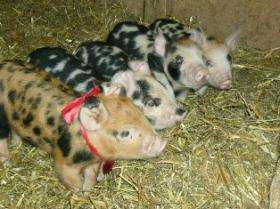Humans are reason for why domestic animals have strange and varied coat colors

(Physorg.com) -- Humans have actively changed the coats of domestic animals by cherry-picking rare genetic mutations, causing variations such as different colours, bands and spots, according to a new study.
The study on wild and domestic pigs by Uppsala and Durham Universities, published today in the open access journal PLoS Genetics, reveals that the genetic changes happened over thousands of years.
Although the study was carried out on pigs, the results can explain the evolution in the coat colours of all domesticated animals as they all express the same melanocortin-1 receptor (MC1R) gene, one of the genes that controls coat colour in animals.
The study also explains for the first time why there is a stark contrast between the coat colours of wild and domestic animals and gives further insight into the process of evolution, particularly since animals were first domesticated about 10,000 years ago.
Study co-author Dr Greger Larson, of Durham University's Department of Archaeology, said: "The Mesopotamians had different coloured farm animals 5,000 years ago, and in that regard they were no different to Paris Hilton, who has a pink Chihuahua, or anyone else with animals with unusual coat colours. This study demonstrates that the human penchant for novelty stretches back thousands of years."
For the study, the researchers studied one of the key genes controlling coat colour in animals, the melanocortin-1 receptor (MC1R) gene, in samples of modern wild and domestic pigs from Europe and Asia.
They looked at the DNA sequences of both types of pigs and the effects of the mutations on the protein. While DNA mutations are a natural part of the evolutionary process, some have no effect on the protein, while others can results in different coat colours and strange patterns.
DNA mutations were observed in both wild and domestic pigs. However, in the wild pigs, which have a uniformly black-brown coloured, highly camouflaged coat, none of the mutations altered the protein or the coat colour. Researchers say it is likely that any mutations that resulted in coat colour changes were rapidly selected out of the population by predators, ensuring that the mutation disappeared.
In the domestic pigs, nearly all of the observed mutations changed the protein. In some cases there were three consecutive, or layered mutations - evidence that the initial mutations have been around for a long time. Researchers say this shows that the mutations and resulting coat colour changes were actively encouraged and perpetuated by farmers over thousands of years.
Dr Greger Larson added: "Early farmers may have decided to change the coat of their livestock for a number of reasons. One is that it facilitated animal husbandry since it is easier to keep track of livestock that are not camouflaged. Another could be that it has acted as a metaphor for the improved characteristics of the early forms of livestock compared with their wild ancestors. A third possibility is that the early farmers were as amused and as taken with biological novelty and diversity as we are today."
Professor Leif Andersson of Uppsala University, Sweden, who led the study, said: "Our study settles the debate by showing that the prime reason for the disparity in coat colour is intentional selection by humans. It also shows how quickly a protein can change under strong selection and how humans have created black-spotted pigs, for example, by selecting several consecutive mutations that have occurred by a random process."
Provided by Durham University















